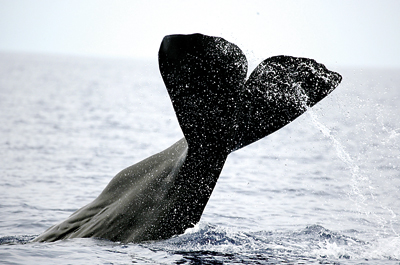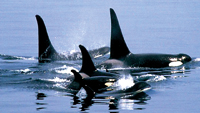Sri Lanka best chance for sperm whale super-pods
It seemed that all of Sri Lanka’s top stories on whale watching of international significance had already been broken. But I can now announce another: Sri Lanka is the best chance in the world for seeing a super-pod of sperm whales on a commercial whale watch. Super-pods of whales and dolphins (cetaceans) form occasionally when smaller pods gather into larger super-pods for feeding or socialising.
Sperm whales, the largest of the toothed whales, are also the largest toothed predators on the planet. The males are larger than females and can grow to over 20 metres in length and weigh over 50 metric tonnes. They are the elephants of the sea with complex social structures with different social groups having different dialects or codas. This species has fascinated people for centuries and sperm whales have been the focus of some of the most celebrated literary works such as Hermann Melville’s Moby Dick and to this day, entire books are centred on them. There is an enormous fascination and intellectual appetite for sperm whales all over the world. Yet, so far, no country has made the claim that it offers the best chance for seeing a super-pod of sperm whales.
I began researching in earnest the theory that Sri Lanka is the best chance for sperm whale super pods following two field engagements in April 2012. The first was hosted by Chaaya Blu in Trincomalee. Three weeks after a super-pod had been seen in mid March, I went to sea with my family and a friend, Tilak Conrad. We were able to record on stills and video a spectacular display of surface behaviour by sperm whales off Trincomalee.
A few days earlier, at Kalpitiya, on a visit hosted by Little Adventures and Bay Watch Eco Resort Village, on two consecutive days, Ashan Seneviratne, Riaz Cader and I caught up with the tail-end of a super-pod of 50 sperm whales. Cader, incidentally, had questioned me previously why I was not publicising the super-pods for tourism. The answer was that firstly, there was little data at that time on numbers and the encounter rate. Secondly, I was a little confused with the literature and was not sure if the super-pods seen off Sri Lanka were internationally-significant. In some of the older books on whale watching and even now in an internet search, one will come up with references and claims to thousands of sperm whales being together. If it was true that sightings of thousands of sperm whales is not unheard of, Sri Lanka could not be so special.
To understand exactly how special Sri Lanka’s super-pods might be, I knew I had to contact both Mark Carwardine, the best-known popular whale watching writer and tour leader and Hal Whitehead, the international authority on sperm whales. I did not have a reply from Carwardine in time for my article for Hi Magazine in June 2012 but Whitehead had emailed me to say that pods of 40-plus sperm whales are common in the Pacific. So, I then announced a view that Sri Lanka may be the best chance outside the Pacific to see a super-pod. But this did not seem right as I could not find any first-hand accounts of people on commercial whale watching trips encountering super-pods in the Pacific. Later, I was able to obtain further clarification from Whitehead.
He emailed me on June 16, 2012 to comment “There is very little commercial sperm whale watching in the Pacific, to my knowledge. With most places in the Pacific that I know of, the whales are far at sea and so not easily accessible. But the Sea of Cortez is fantastic, but there is only a little commercial whale-watching that I am aware of”.
This was preceded by an email from Mark Carwardine who wrote ‘These super-pods in Sri Lanka sound very exciting. The only time I have ever seen more than 40 sperm whales together in a single pod was once in the Sea of Cortez, Mexico, when I counted 51. They really aren’t very common at all”. The two comments by Carwardine and Whitehead are very strongly suggestive that Sri Lanka’s super-pods are special and such numbers are not regularly encountered on commercial whale watching elsewhere in the world.

Stunning sight: Sperm Whales off Trincomalee. Pix by Gehan de Silva Wijeyeratne
To see pods of sperm whales, one has to travel to tropical destinations such as the Azores, Dominica and Baja California, where the ‘breeding schools’ are found. The higher latitudes tend to have resident males. In dialogue with whale watching companies, marine mammal tour leaders, photographers, writers and researchers, I gained further reinforcement or assurance that pods in these countries rarely exceed 20. For example, Dylan Walker, co-founder of www.planetwhale.com, co-founder of the Whale Festival in the UK and the author of two books on whale watching emailed me his comments on June 23, 2012. He wrote “Seeing 40 sperm whales sounds like a lot for a commercial whale watching trip. All the places I can think of generally see less.”
Contrast that with Sri Lanka where between March and April 2012, Sri Lanka had nine days when sperm whale super-pods of over 40 individuals were recorded. These were April 6, 2012 in Mirissa, March 20- 23, 2012 (inclusive) in Trincomalee (estimates varying from 60 to 200) and April 14-17, 2012 (inclusive) in Kalpitiya. If seeing a pod of 40 plus sperm whales is remarkable, why are there confusing references as mentioned above to thousands of sperm whales? The answer may lie in a confusion being introduced when information is quoted from Whitehead’s seminal book ‘Sperm Whales: Social Evolution in the Ocean’. In Chapter 6.1, he describes ‘concentrations’ whereby, during large scale surveys, sperm whales are encountered in patches of a few hundred kilometres and ‘aggregations’ within concentrations which span 10-20 kilometres across. Whitehead, using his South Pacific data, estimates that approximately 750 sperm whales may be found in a concentration spanning 300km. I suspect it is such estimates over large spatial scales in the scientific literature which has led to references in the popular whale watching literature to thousands of sperm whales being together or being seen together.
However, co-ordinated movement of animals is at the social scale of a ‘group’. Groups are defined as animals moving together in a coordinated fashion over periods of at least hours. These groups are the same as ‘pods’ to whale watchers, that is, what a whale watcher can see around them in their field of view. Table 6.1 in Whitehead’s book lists mean sizes of groups from various studies. The mean pod sizes listed range from 18 to 29.8. This does not contradict the feedback from whale watching professionals that the pods seen off Sri Lanka of 40-plus are special.
I hope I have explained the confusion over the myth on the internet and in the older books about sperm whales in their thousands and reconciled it to the different scales employed by scientists versus professional whale watchers whose spatial scale is the immediate field of view.
It is clear that seeing a pod of over 40 on a commercial whale watch is very special. Since the publication of the article in Hi Magazine, I also received data from marine biologist Ranil Senanayake of super-pods he has encountered between March 2010 and May 2011. Four additional super-pods recorded by Senanayake include one off Mullaitivu (May 24, 2010) as well as the sites referred to earlier off Trincomalee (May 9, 2011), Kalpitiya (March 11, 2010) and Mirissa (March 19, 2011). Furthermore, between January 2010 and December 2011, naturalist Anoma Alagiyawadu has recorded a further four pods of over 40 sperm whales off Mirissa including two (January 29,2010 and April 24, 2011) which had over 50. Therefore, between January 2010 and April 2012, Sri Lanka had 17 super-pod days of over 40 sperm whales.
Based on the available data, it appears that Sri Lanka is the best chance in the world for seeing a super-pod of sperm whales on a commercial whale watching trip. However, note that I use the word chance, as sightings are unpredictable. As more and more people become attuned to the sperm whales off Kalpitiya and Trincomalee, the number of sperm whale ‘super-pod days’ recorded off Sri Lanka will increase. But sperm whale super-pods will remain a chance event.
It is also important to realise that no claim is being made that Sri Lanka is the most reliable location for seeing sperm whales. Film crews with limited time may opt for a location like Kaikoura with its resident males, or the smaller pods encountered frequently off the Azores and Dominica. If the currently limited commercial whale watching for sperm whales takes off in the Sea of Cortez, that location could become a contender to be the best chance for a sperm whale super-pod. With or without film crews, the island now has another big wildlife story for the print media.
The sperm whale super-pods are a tool in the island’s media armoury to gain millions of dollars of free publicity. Positive brand publicity attaching to Sri Lanka through its sperm whale super-pods could have a wide economic impact. For example, Britain attracts the most Foreign Direct Investment (FDI) of countries in Europe. Interestingly, according to the 2011 UK Attractiveness Survey by Big Four accountancy firm Ernst and Young, quality of life and culture are considered key determinants for Britain out-competing other European countries. ‘Quality of life’ signals from whale watching in the beautiful Indian Ocean leading to potential FDI benefits, should add further impetus for Sri Lanka to conserve its whales and dolphins and encourage their viewing through regulated, responsible whale watching.
comments powered by Disqus























